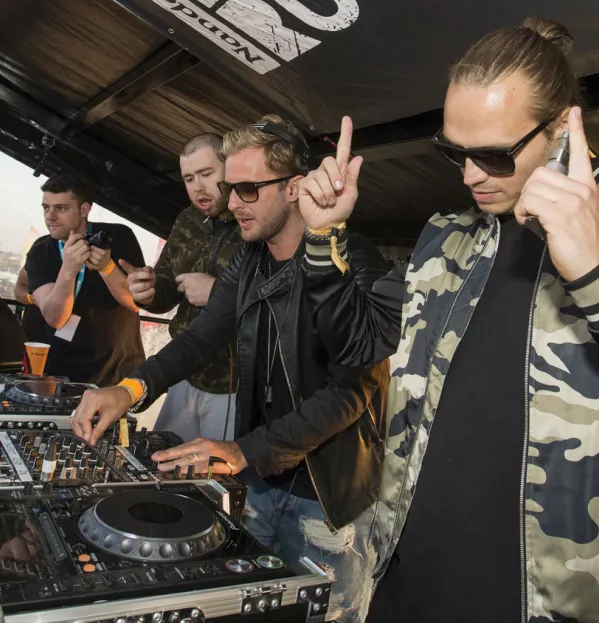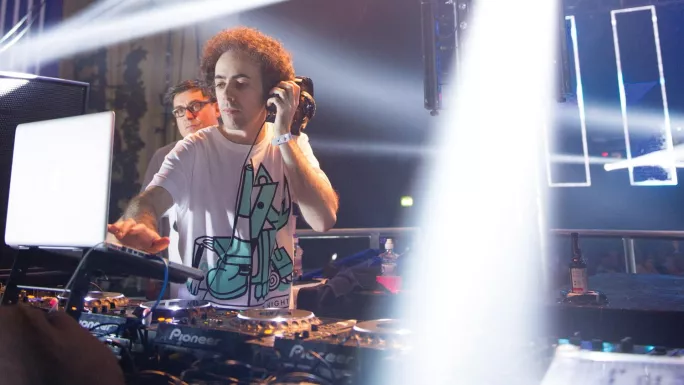Teach bleeps, rave, repeat

“The music teacher at my senior school was very open-minded and encouraging,” recalls Joe Lenzie, one half of the hugely successful drum and bass crossover act Sigma. “He let me and my brother perform a jungle remix of Pachelbel’s Canon in assembly when I was 11.”
Twenty-two years later, Lenzie performs jungle to crowds of thousands and has topped the charts on two occasions.
He credits his success to the early influence of his music teacher but believes such open-mindedness is rare. It would seem many agree that music education in schools does not do enough to embrace electronic music. Classical, pop, rock, rap all have a place. But dance music? It rarely gets a look in.
The signs are that this might change. For starters, the outdated vision of electronic music as the backdrop to the lawless hedonism associated with late 1980s/early 1990s rave culture is beginning to fade out. The modern iteration of electronic music is a far cry from that.
Second, there is a wider recognition that electronic music is as valid as other genres - a medium with genuine scale and enough scope to be a viable career route for young people. In just three years, the global electronic music industry’s value has risen 60 per cent to $7.1 billion (£5.7 billion). Electronic music, in all its forms, is now a booming global commercial operation with more career opportunities than ever before.
In the UK, electronic music has dominated streaming, sales and Google search charts for several years as the most popular musical genre. Its presence and influence is felt across a large number of mainstream pop tracks, with the official chart regularly topped by dance music. There is also an exciting underground scene, in which opportunities have opened up thanks to the internet, the development of faster, cheaper computer processing power and the accessibility of software.
Of course, very few electronic music artists make millions; many have to work full-time in the studio during the week and tour the world’s clubs every weekend to make a living. Some still work a day job. But it’s the same story for most musicians. And the means to produce, proliferate and promote dance music have never been easier to access. It is arguably an easier genre than others in which to pursue a career to the heights of Sigma - or another huge dance act, High Contrast (pictured, below).

Laws of the jungle
The members of Sigma and High Contrast are in their thirties. They are known for a particular style of dance music called drum and bass - a UK-born sound that’s faster than other genres, at typically 160-180 beats per minute, and is often referred to as jungle. Both sets of performers were also products of the UK state school system, but had very different experiences.
Lenzie, as mentioned above, found a willing supporter in his music teacher for the direction he wanted to take, but the kit was not available in the classroom for him to hone his craft.
Lincoln Barrett, the man behind High Contrast, did not even get moral support.
“It all seemed very rigid,” he recalls. “Everything was focused on traditional instruments, and traditional rules and grades and tests. This, to me, goes against what motivates and inspires most people in electronic music. It’s a genre that is inherently based on breaking rules and thinking differently.
“My own personal experience of music education didn’t encourage this at all - grades and tests are only really appropriate for those wishing to pursue a very specific skill on a traditional instrument.”
Plenty of music departments in schools will still dictate that students study the canon and the rules, while shunting electronic music to personal projects out of school time. You can see the reasoning: just as you learn the rules of grammar before you break them, music should be the same; and just as we have traditional set texts in English, the same should be true in music.
Except that electronic music does not necessarily break any rules; children are also free to pursue creative as well as formal writing, so why not have the same arrangement for music? As for set texts, there is a similar argument for electronic music as for young adult fiction. Both genres are derided by traditionalists, but for so many kids, both are a gateway to the established canon.
Who says the newness of something means it is less rigorous or important?
Many music teachers I spoke to agreed that approaching music education in a way that was more open to electronic music remained contentious, but things are starting to change.
The high notes
Sara Thomas, leader of music at the federated Michaelston Community College and Glyn Derw High School in South Wales, is a firm believer in the potential of electronic music. She says this is not just pandering to those who enjoy listening to it. Rather, the genre is fantastic for helping all young musicians to think differently and try new things.
“Students’ composing skills aren’t hindered by their level of playing ability or performing capabilities with electronic music,” she explains. “If they have really exciting ideas in their heads, electronic techniques can help them realise those ideas and learn from their mistakes. Software such as Logic and Pro Tools is hugely beneficial for all young musicians; ones that are interested in electronic music and ones that play traditional instruments. It also means students don’t have to wait on a larger group of peers to record something. They can layer things on their own.”
Richard Bannister, music technology teacher at Highcliffe School in Christchurch, agrees that sequencing software doesn’t have to appeal to music students who aren’t interested in electronic music production. In his words, showing them how to create entire songs on their own is a great way to “encourage technophobes”.
‘If students have exciting ideas, electronic techniques can help realise them’
What’s interesting is that technophobe students still exist in a generation that is growing up in the digital age. “The technology that people use on a day-to-day basis hasn’t translated into the school experience in terms of music education,” Bannister says.
“Essentially, the interfaces we use haven’t changed over this time - it’s still a digital audio workstation on a computer, a screen, a mouse and clicks. Ostensibly, nothing has changed. So in regards to kids being more involved or engaged with the technology, I don’t think they see the music tech as an extension of the technology they use on a day-to-day basis.”
That’s not to say that electronic music should simply be a tool to facilitate a greater understanding of music tech in general, nor a vehicle to get every student composing - important though those uses are. Barrett and Lenzie stress that a change of attitude towards electronic music is needed in music education.
Creative compulsion
“It’s a very hard business to persevere in - you have to eat, sleep, breathe it and even then there are no guarantees you’ll make it,” admits Lenzie, who recently collaborated with Take That. “But when you love the music, you accept that as part of it. And any student who shows that level of interest or potential to show that commitment should be encouraged anyway.”
That might occasionally mean teachers swallowing their own opinions, says Barrett, who co-wrote the music for the 2012 Olympics Opening Ceremony (among many other impressive entries on his CV).
“Through my own personal experience, I’ve found that learning a creative topic or skill in an institutional environment, with the pressure of grades, can quash your passion and interest,” states the film graduate, who once had dreams of becoming a director. “Everything I know about music, I’ve taught myself. I know I do things that would make traditional musicians or music teachers, scream. But it’s worked for me so far and I actively think we should all - myself, my peers, teachers, all of us - encourage creative thinking as much as possible.”
‘We should all encourage creative thinking as much as possible’
Lenzie feels that this level of encouragement should be shown by all teachers, not just music-department staff. While his music teacher understood his passion and ambition, and helped to channel his creative freedom, the teacher responsible for his work experience placement put him to work in retail: in a music shop.
Plenty of teachers will say they already encourage their pupils’ musical interests, but it’s unlikely that the majority will understand electronic music enough to genuinely see its merits.
The real shift that Lenzie, Barrett, the electronic music industry and those teachers already embracing the genre strive for is that electronic music should become recognised as an established art form with its own set of musical rules - one that is part of an industry offering all manner of career opportunities for aspiring musicians.
In the midst of an unstable economy and cuts to all forms of arts funding, that’s something that should not to be ignored.
Dave Jenkins is a freelance journalist specialising in the music industry and tweets as @davethejenkins
You need a Tes subscription to read this article
Subscribe now to read this article and get other subscriber-only content:
- Unlimited access to all Tes magazine content
- Exclusive subscriber-only stories
- Award-winning email newsletters
Already a subscriber? Log in
You need a subscription to read this article
Subscribe now to read this article and get other subscriber-only content, including:
- Unlimited access to all Tes magazine content
- Exclusive subscriber-only stories
- Award-winning email newsletters